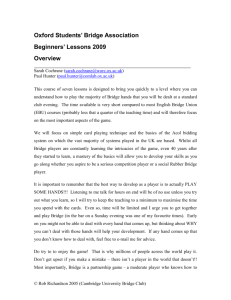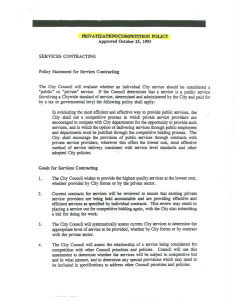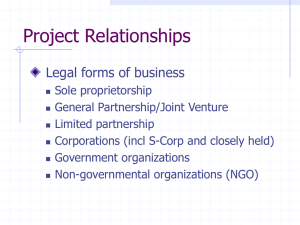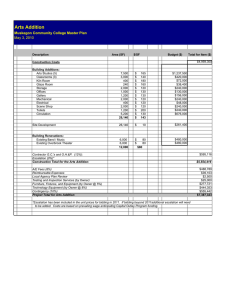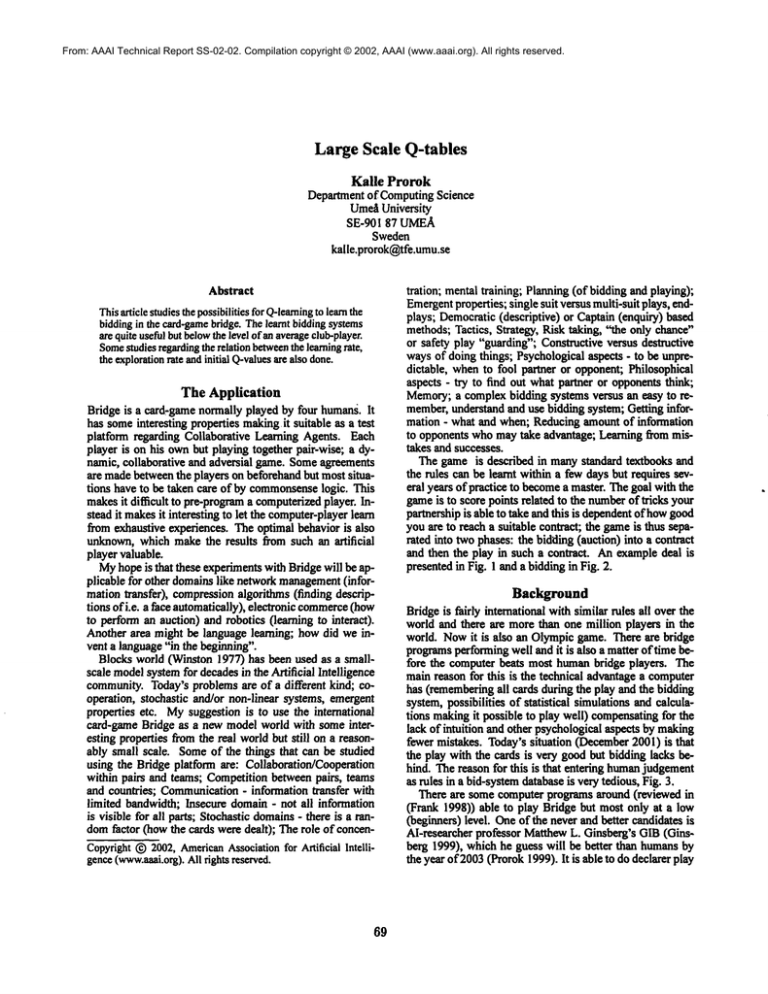
From: AAAI Technical Report SS-02-02. Compilation copyright © 2002, AAAI (www.aaai.org). All rights reserved.
Large Scale Q-tables
Kaile Prorok
Departmentof ComputingScience
Ume~University
SE-901 87 UMEA
Sweden
kalle.prorok@tfe.umu.se
Abstract
Thisarticle studiesthe possibilitiesfor Q-learning
to learnthe
biddingin the card-game
bridge.Thelearnt biddingsystems
are quiteusefulbutbelowthe level of an average
club-player.
Some
studiesregardingthe relationbetween
the learningrate,
the exploration
rate andinitial Q-values
are alsodone.
The Application
Bridge is a card-gamenormallyplayed by four humans.It
has someinteresting properties making.itsuitable as a test
platform regarding Collaborative Learning Agents. Each
player is on his ownbut playing together pair-wise; a dynamic, collaborative and adversial game. Someagreements
are madebetweenthe players on beforehandbut mostsituations have to be taken care of by commonsense
logic. This
makesit difficult to pre-programa computerized
player. Instead it makesit interesting to let the computer-player
learn
from exhaustive experiences. The optimal behavior is also
unknown,which makethe results from such an artificial
player valuable.
Myhopeis that these experimentswith Bridgewill be applicable for other domainslike networkmanagement
(informationtransfer), compressionalgorithms(finding descriptions of i.e. a face automatically),electronic commerce
(how
to performan auction) and robotics (learning to interact).
Another area might be language learning; howdid we invent a language"in the beginning".
Blocks world (Winston1977) has been used as a smallscale modelsystemfor decadesin the Artificial Intelligence
community.Today’sproblemsare of a different kind; cooperation, stochastic and/or non-linear systems, emergent
properties etc. Mysuggestion is to use the international
card-gameBridge as a newmodel world with someinteresting properties fromthe real worldbut still on a reasonably small scale. Someof the things that can be studied
using the Bridge platform are: Collaboration/Cooperation
within pairs and teams; Competitionbetweenpairs, teams
and countries; Communication
- information transfer with
limited bandwidth;Insecure domain- not all information
is visible for all parts; Stochasticdomains- there is a randomfactor (bowthe cards were dealt); The role of concertCopyright
(g) 2002,American
Associationfor Artificial Intelligence(www.aaai.org).
All rights reserved.
69
tration; mentaltraining; Planning(of biddingand playing);
Emergent
properties; single suit versus multi-suit plays, endplays; Democratic(descriptive) or Captain (enquiry) based
methods;Tactics, Strategy, Risk taking, "the only chance"
or safety play "guarding"; Constructiveversus destructive
waysof doing things; Psychologicalaspects - to be unpredictable, whento fool partner or opponent;Philosophical
aspects - try to find out whatpartner or opponentsthink;
Memory;a complexbidding systems versus an easy to remember,understandand use bidding system; Getting information - what and when; Reducingamountof information
to opponents whomaytake advantage; Learning from mistakes and successes.
The gameis described in manystandard textbooks and
the rules can be learnt within a fewdays but requires several years of practice to become
a master. Thegoal with the
gameis to score points related to the numberof tricks your
partnershipis able to take and this is dependentof howgood
youare to reach a suitable contract; the gameis thus separated into twophases: the bidding (auction) into a contract
and then the play in such a contract. Anexampledeal is
presentedin Fig. 1 and a biddingin Fig. 2.
Background
Bridgeis fairly international withsimilar rules all overthe
world and there are more than one million players in the
world. Nowit is also an Olympicgame. There are bridge
programsperformingwell and it is also a matter of time before the computerbeats most humanbridge players. The
mainreason for this is the technical advantagea computer
has (rememberingall cards during the play and the bidding
system,possibilities of statistical simulationsand calculations makingit possible to play well) compensating
for the
lack of intuition and other psychologicalaspects by making
fewer mistakes. Today’ssituation (December2001) is that
the play with the cards is very goodbut bidding lacks behind. The reason for this is that entering humanjudgement
as rules in a bid-systemdatabaseis verytedious, Fig. 3.
There are somecomputerprogramsaround (reviewed in
(Frank 1998)) able to play Bridge but most only at a
(beginners)level. Oneof the never and better candidates
AI-researcher professor MatthewL. Ginsberg’s GIB(Ginsberg 1999), whichhe guess will be better than humansby
the year of 2003(Prorok1999).It is able to do declarer play
North/Deal
4iv T9632
¯ T72
6 QT873
West
East
¯ AJT842
AK7
* Q963
v 85
¯ AJ64
4. J86
South
* K75
v QJ4
¯ K92
4. K953
¯5
4. AQ4
Figure 1: A typical deal in schematicform. It is dealt by
player North whothen starts the bidding with East next in
turn. Northis void in (have no) spades but has a weakhand
and passes. East has a strong hand and normallyopens the
bidding by giving a bid, maybe1 6. South has an average
hand but not enoughto enter the bidding with a bid other
than Pass.
N E SW
P 18P 24
P 4*P P
P
Figure 2: The schemaof one possible bidding with the hands
in Fig 1. Threepasses ends the auction. 4 Ik requires EWto
take 6 ("the book")+ 4 = 10 tricks out of the possible 13.
1"#08115" {5{[CDHS]:"
!.!
%0% %.% <0x1083>"2153"#08116"
5[÷#b]"
!DOPI!
%6% %:H[~:]*~8&[^:]*-S&%
"2160"#08117"
5[+÷#b]"
!DOPI!
%7%
t:H[^:|*-8&[^:]*~8&{^:J*~8&t
"2159"#08118" 5[+++#b]"
!DOPI[
18% %:H~8&.’S&.’S&.~8&%
"2156"#08119" 4N:$7"
!.!
"
%0% t.t *1501"#08120 {SNI[67][CDHSN]):" !.!
"
%0% %.% <0x1083>"2153"#08121
X"
!DOPI!
"
%3% I.% "2154"#08122
P"
!DOPI!
!DOPI!
%4% %:H[^:]*’S&%"2155"#08123"
X"
%5% %:H[^:]*~8&[^:]*~8&%
"2154"#08124" P"
!DOPI!
%6%
%:H[^:]*~8~[^:]*’8&|^:]*-8~%
"2155"#00126"
.*{|{{{[I||{{[[CDHS]<#j=3><#k=6>:P:4N"
!.!
%0% %.% *2037*#00127" :(PIX):"
!.!
"
[BLACRWOOD!
%0~ I.%#00128
@ACE BLACKWOOD-"
Ii% %.% "1501"#00129"
8ACE RKCB-"
[RKCB!
%1% %.%#00130" [1231{{{{{|{{T{(({.:P:5N$12" !GSF!
"
%0% t.% "2229"#00131 :,:"
!,[
%0% %.%~00132" 7#a"
!.!
"
!.!
%5% %:H[~:]*-9>#a%
*2034*#00133
7#a"
!.!
%5% %:H[*:]*-6=#a%
*2034*#00134"
6#a"
Figure 3: A small part of the GIB-database, showinghow
the Ace-asking bid Blackwood(4NT) should be used.
7O
on a very high level. This also makesthe biddingbetter becauseit simulatesthe play to find the best or mostprobable
contract.
GIBusestheBorelsimulations
algorithm
(Ginsberg
1999):
Toselect
a bidfrom
a candidate
setB,given
a databaseZ that
suggest
bids
invarious
situations:
I.Construct
a setD ofdeals
consistent
withthe
bidding
thus
far.
2,Foreachbidb E B andeachdeald E D usethe
database
Z toproject
howtheauction
willcontinue
if
thebidb ismade.
(Ifnobidissuggested
bythedatabase,
theplayer
inquestion
isassumed
topass.)
Computethedouble-dummy
result
oftheeventual
contract,
denoting
its(b,
d).
3.Return
that
b forwhich
Y’~a
s(b,
d)ismaximal.
There
aredozens
of other
programs
forplaying,
generatingdeals(Andrews
1999)etc,fanFrankhasmade
end-play
analyzer/planner
FINESSE
whichseemstowork
wellbuttooslowforpractical
use(written
ininterpreted
PROLOG)
andhehasalsowritten
anexcellent
doctoral’s
thesis "Search and Planning UnderIncompleteInformation"
(Frank 1998). PYTHON,
(Sterling & Nygate1990) as cited
in (Bj6mGamback
&Pell. 1993) is an end-play analyzer for
findingthe best play but not on howto reach these positions.
The former World Bridge ChampionZia Mahmood
has
offered one million poundsto the designer of a computer
systemcapable of defeating him but has withdrawnhis offer
after the last matchagainst GIBwhichwasa narrowwinfor
him.
Most programsbasically use a rule-based approach. The
first one (Carley 1962)with four (I) bidding rules with
performance
like "Theability level is about that of a person
whohas played dozenor so hands of bridge and has little
interest in the game".Wasserman
(cited from(Frank 1998))
divides the rules into collection of classes that handledifferent types of bid, such as openingbids, respondingbids
or conventional bids. The classes are organized by procedures into sequences."Siightlymoreskillful than the average
duplicate Bridge player at competitive bidding". MacLeod
(MacLeod1991)(cited from (Frank 1998)) tries to build
picture of cards a player holds but cannotrepresent disjunction; whena bid has morethan one possible interpretation.
Staniers (Startler 1977)(citedfrom(Frank1998)) inlroduces
look-ahead search as an element of Bayesian planning and
LindeR$f’sCOBRA
(Lindelof 1983)uses quantitative adjustmerits. Lindel6fclaimsthat COBRA
bidding is of world expert standard. Ginsberghas invented a relatively compact
but cumbersome
(Fig. 3) way of representing bidding systemsin his GIB-soi~vare.By using such representations he
reduceda rule-base of about30,000rules into one with about
5,000. Suchrepresentationsare of course proneto errors.
The Rules of Bridge
Bridge is a card gameplayed with a deck of 52 cards. The
deck is composedof 4 suits (spades 6, hearts ~, diamonds
<> and clubs &). Eachsuit contains 13 cards with the Ace
as the highest value and then the King, Queen,Jack, Ten, 9,
.... 2. Thefirst five are often abbreviatedto A, K, Q, J, T.
The gamebegins with someshuffling of the deck and then
the cards are dealt to the four players, often denotedNorth,
South, East and West (N, S, E, W)Fig. 1. N and S play
together in a team against E and W.
Before the card play begins an auction (bidding) takes
place. Oneof the teamst wins a contract to makeat least
a certain numberof tricks. Somelevels give bonuspoints.
Topreventopponentsfromtaking a lot of tricks in a long
suit of theirs, a trump-suitis lookedfor in the bidding. If
no common
trumpsuit is found, a gamewithout trumps can
maybebe played; No Trump(NT), which is ranked higher
in the biddingthan the suits whichare ranked6 (lowest),
~, to 6 (highest).
Duringthese twophases, the bidding and the play, there
is cooperationin pairs playing versus each other with four
players at each table. The pairs communicatevia bidding
wherethe bids are limited to a few (15) "words", but many
sequences"sentences/dialogs" are possible. Opponentsare
2 about the meaning(semantics) of the bid
kept informed
sequence. This can be seen as a mini-languagewith words
like 4, 1, Spades, Double, Pass etc. and these words can
be combinedvia simple grammaticalrules into short "sentences" like 3 Spades.The sentences are put in a sequence
"conversation"called the bidding. It can look like N:Pass
- E:I Spade - S:Pass - W:2Spades, N:Pass - E:4 Spades
- S:Pass - W:Pass, N:Passwith semantic meaningslike "I
havea handwith spades as the longest suit and aboveaverage numberof Aces, Kingsand Queens"- "I have support
for your spades but not so goodhand", "I have someextra
strength"- "1 havenothingto add". Thefirst non-passbid is
denotedopening.A full bidding schemais presented in Fig.
2.
When
the biddingis finished, a pair handlesthe final contract (4 spades here) and the play with the cards can begin
by taking tricks. After the play, the pairs are given points
accordingto the result. In tournamentplay the points are
comparedto the other pairs playing a duplicate3 version of
the deal, almost compensating
the factor of luck with "good
cards".
In our workwe have studied undisturbed bidding which
meansthe pair is free to bid on their ownwithout disturbing interventions from the opponents. Thereis no need for
preemptivebids and sacrificing or to keep in mindthe importance of reducingthe amountof informationtransferred
to the opponents.By havingthese limitations weare able to
learn better in shorter time. Less memory
is also needed.
Representation
A bridge-hand as a humanviews it is seen in Fig. 4. A
shorter, standard, representation with almost the samemeaning (losing the graphic"personality"of the cards)
Figure 4: A typical hand
Card
Ace
King
Queen
Jack
Highcard points (h.c.p.)
4
3
2
1
Table1: Theestimatedstrength of the high cards.
6AK87
cYQJ52
QQ7
6T96
or, simply, AK87,Q J52, Q7, T96with the order of the
suits understood. The total numberof possible hands are
6 ¯ 1011. There are 8192different suit holdings
92, AK82,etc.), and only 39 hand patterns (5431,5422,
etc. disregardingsuit-order) (Andrews1999)and 560shapes
(5431,4513, 5422,.) in total. To estimate the strength in
hand, Milton Worksinvented the high card points (h.c.p.)
(table 1).
The total numberof h.c.p, in a deck is 40 and the average strength per hand is exactly 10. A hand with AKQJ,
AKQ,AKQ,AKQcontains 37 points which is the maximum.Suchevaluations are neededto estimate the numberof
tricks a pair of handsare able to take. RobinHillyard(Hillyard 2001) has calculated the expected numberof ~cks at
no trump, presented in table 2 basedon G1B-simulations
and
the results are close to basic rules of thumbused by bridgeplayers. ThomasAndrews(Andrews1999) has made some
analysis showingthat the value of the Aceis slightly underestimated in the MiltonWorks432 l-scale.
Of coursethis scale is just to makean roughestimateof a
handand every bridgeplayeradjust (reestimate) the value
the hand, maybedynamicallyduring the bidding due to fit
~
etc.
Oneadd-onadjustment invented by Charles Gorenis the
distributional strength (Table3) wherethe total value of our
hand is 12 (h.c.p) + 1 (doubleton ~) = 13 points.
H.c.p 20
Tricks 6.1
21
6.7
22
7.2
23
7.6
24
8.2
25
8.7
H.c.p 26 27 28 29
30
Tricks 9.1 9.7 10.1 10.6 11.1
t Withthe highestbid.
21ftheyask.
3Or replayed
later bystoringthe dealin a wallet.
Table2: Theaveragenumberof tricks with a given strength.
71
Number
of cards in a suit
no card (void)
one (singleton)
two (doubleton)
Distributional value
3
2
I
Whatvalue of the rewardr should the evaluator give the
learners?
a) Calculatethe differencebetweenthe actual score to the
score achievableon this combinationof hands:
Table3: Distributionalpoints.
r = score - achievable
idea behindis that shortage in a suit makesit possible to.
ruff in a trumpcontract andtherebyincreases the strength of
thehand.Thesedistributional
pointsare normally
notadded
during a search for a no trump(hiT) contract. Thestrength
is used to define a bidding systemin terms of shape-groups
and strength intervals.
Our hand can be represented as a 4423-shape(4 spades,
4 hearts, 2 diamondsand 3 clubs) with the strength of 12
h.c.p. Thenumberof possiblehandsin this representationis
560 ¯ 38 = 21180. In our approachwe reduce it further by
just keepingthe distribution of the cards (the shape), andthe
rangeof strength:
4432, medium
where mediummight show12-14 (Goren)points.
Allowedsystems In most real tournaments the possible
systems are limited by assigning penalty points (dots)
non-natural opening bids (Svenska BridgefOrbundet, SBF
and WorldBridgeFederation, WBF).This is so becauseit is
difficult for a humanopponentto find a reasonabledefence
within a fewminutesto a highly artificial biddingsystem.A
certain numberof points are alloweddependingon the type
of tournament.
:
---- qsituat,bid q- lr *
(7" q- "7 I~ida~ qsituat’,bid’ -- qsltuat,bid)
It worksbadly due to high exploration. Assuming
a start
value of Q withzero "optimisticstart", almostall tried bids
will start with negative scores (strange contracts) making
themworsethan hitherto untested alternatives. This will
lead to a huge, time consumingexploration phaseof all alternatives.
b) Differenceas abovebut added200 points:
r = score - achievable + 200
(3)
A contract not worsethan -200 is denotedbetter than the
untested cases. The Pass alwayssystemevolved guaranteeing a score of 200. Maybe
a long run will improvethis policy
and the pass-systemis a kind of eye of a needle?
c) Absolutescore. Simplyreinforce the learner by the
actual score:
r = score * 10
(4)
It workedbest, at least on our short (oneday or two)runs.
Thescore was sealed with 10 to try to avoid integer roundofferrors whenmultipliedby the learning rates.
d) Heuristic reinforcement.
r’ = r - 100 * isToHighBid
(5)
To avoid high-level bidding with bad cards there wasan
extra negative reinforcementon those bids that were above
the optimalcontract.
The Learning
The Q-learning (Watkins &Dayan1992) updating rule
qsituat,bid
(2)
(1)
wasusedfor all three (response,rebid, 2ndresponse)bidding positions (whenapplicable) after each deal. Theshape,
strength, position (E,W)and bid-sequence is encoded
part of the situation and the q-valueswere stored in a multidimensionalinteger array, q is the averageresulting score
havingthis handand followingthe policy, lr is the learning
rate, 7 the discount rate and r is the reward. The bid with
the highestq wasselected in a particular situation unless exploration was actual, on which any bid was selected with
equal probability. If several bids had the sameq-value, one
of themwas randomlyselected.
In practice this meantone out of 2048opener werecombined with one of the 2048respondersaccordingto the current examplein the databaseand they had to learn together
with their partners; thence multi-agentreinforcementlearning. The pair’s q-values wereupdated whenthe bidding was
finished. This wasrepeatedmultiple times.
Reinforcement signal
Somepreliminary tests with the rewardwasdone.
?2
Discount/Decay
How
far-sighted should the bidders be’?. Byselecting different values for -y in the Q-learningdifferent behaviorswas
obtained. A lowvalue makethe learners prefer a short bidding sequenceand resulted in guessinginto 3NTmoreoften.
Maybea value higher (not tested) than the normallimit
one will encouragea moreinformative, long sequence?Eligibility traces wasnot usedbut the result after the bidding
wasusedfor all pohitions.
Results
Someof the ideas above were implementedin a program
called "Reese", after the famous bridge player Terence
Reese who died 1996. He was knownfor his excellent
booksand simple and logical bidding style. Regardingour
bidding programthere was hopefor finding a super-natural
bidding system but so was not the case. This programrequires a computer with at least 348 MBof memorywith
the described configuration. The experimentscan be seen
as what can be achieved with these methodsin a complex
two-learner task and also gives somehints of howto chose
learning parameters.
Introduction
By using the huge databaseof GIB-results whenplaying
againstitself for 717.102deals, wefounda reasonable
evaluative function. Thedatabasewasgeneratedusingan early
versionof GIBbut both the declarerandthe opponents
were
not so strong so maybe
the result is quite reasonableanyhow. Wehave used the 128 most commonshapes which
includesall handswithat mosta six-cardsuit exceptfor the
rare 5440, 5530, 6511, 6430 and6520shapes. This covers
about91%of the handsand, neglectingthe inter-handshape
influence, 0.91.0.91 = 83%of the hand-pairs.Thestrength
wasclassified into the following16 intervals(althoughthis
is easy to modify):
Class
0
1
2
3
h.c.p.
0-3
4-6
7-8
9
Class
5
6
7
4
10
11
12
13
h.c.p.
Class
8
9
10
11
h.c.p.
14
15 16 - 17 18 - 19
Class
12
13
14
15
h.c.p.
20 - 21 22 - 24 25 - 27 28 - 37
Theintervals wereheuristicallyselected in accordance
to
frequencyof appearing.
To reducememory
requirements,learning time and simplify the restriction of learninginto allowedbiddingsystems, the openingbids wasdefined by the user as a small
twopagetable. Partof the definitionof the openingbids in
bidsyst.txt is (the strengths9, 13, 14 and28 wereremoved
here ~r ease of showing:
Shape
6313
6241
6232
6223
6214
6142
6133
6124
5521
5512
5431
5422
5413
5341
5332
0 4
P 3S
P
P 3S
P 3S
P
P
P 3S
P
P
P
P
P
P
P
P
7 i0
2D
2D
2D
2D
11 12
1S
1S
1S
lS
1S
1S
1S
1S
1S
IS
IS
15
IS
IS
IS
IS IN
16
18
20 22 25
2S
2S
2S
2S
2S
2S
2S
2S
2S
2S
2S
2S
2S
2S
IS 2C 2N 2S
Thebidsyst.txt canbe rearranged
(preferablywitha program)fromthis matrixrepresentation
into an inputfile with
examples.Eachstrength 0..37 is used to generatean example, resultingin 128 ¯ 38 = 4864examples,whichlook like
this (high cardpoints, number
of Spades,Hearts,Diamonds,
Clubs, recommended
opening-bid):
0,
i,
2,
3,
4,
6, 4,2, I, pass
6, 4,2, i, pass
6,4,2,l,pass
6, 4,2, l,pass
6, 4,2, i, pass
73
It canbe represented
as a decisiontree or rulesetbut this
introduceserrors (due to somepruning;about2%is erroneous),is larger (five andten pagesrespectively)andconsiderablymorecomplexto read.
The See5, inductive-logic, sotbvare (available via
http://www.rulequest.com)
generatesthe following(slightly
modified)decisiontree:
See5
[Release
1.13]
Wed
Mar
Options:
Generating
rules
Fuzzy thresholds
Pruning confidence
4864
cases
Decision
(5 attributes)
14 2001
level
from
50%
open.data
tree:
pts in [20-38] :
:.s in [5-6] :
: .pts in [25-38]: 2S (390)
: pts in [0-24]
:
: :.pts
in [0-21]
:
:
:
:
:.s in [1-5] :
:
:
: :.d in [5-6] : 2S (4)
:
:
: : d in [1-4] :
:.h in [5-6]: 2S (4)
h in [1-4] :
:.h in [1-2] :
:.d in [1-2] :
: :.d = i: 2S (2)
: : d in [2-6]:
: : :.h = I: 2S (2)
: :
:
:
: ¯
h in [2-6] : IS (2)
.
.
. .
. d in [3-6] :
:
:
: :
: :.h = I: IS (4)
: :
: :
:
h in [2-6] :
:
:
: :
:
:.d in [1-3] : 2C (2)
: :
: :
:
d in [4-6] : IS (2)
:
:
: :
h in [3-6]
:
:
: :
:.h in [4-6]: IS (6)
... (5 pages)
And the ~llowings~ ofrulm(mycommen~
on fight of
the *):
Rule
i: (512, lift 3.9)
pts in [0-3]
-> class
pass [0.998]
* Pass with a very weak hand
Rule
2: (132/2, lift 3.8)
pts in [0-II]
s in [1-3]
h in [1-4]
d in [5-6]
d in [1-5]
-> class
pass [0.978]
* Pass even up to average and 5 diamonds
Rule 3: (39, lift 3.8)
pts in [0-12]
s in [4-6]
s in [1-4]
h in [2-6]
h in [1-2]
d in [1-3]
-> class pass [0.976]
* Pass with up to average and 4 spades
... (i0 pages]
Theprogramuses the original bidsyst.txt andit is doubtful
if the tree or the rules canbe useful to a human
reader.
Noopponentswere taken into accountexcept for the specified openingbids whichincludedpreemptivebids like 2 diamonds(showing a strong hand with diamondsor a weak
hand with a six-card major) and 3 in a suit showinga weak
handwith a six-card suit.
Thedatabase contains a vector with the actual numberof
tricks taken in any suit or no trumph.Wehave assumedEast
to be declarer in all cases due to performancereasons. The
maximum
numberof bids in a row was set to four (a pass
wasautomaticallyaddedas a fifth bid if applicable) and the
numberof possible bids waslimited to sixteen.
Learningrates wereencodedas integers and shifted right
ten steps, effectively scaling them downwith a factor of
1024. Explorationrates wasinteger codedin parts per thousand. A T-value of zero wasused and the initial values of
the Q-tables for east and west respectively was a command
line argument. The exampleswere separate! in a training
and a test set and training exampleswere selected in randomorder to avoid biasing effects. The desired numberof
exampleswere selected in order from the database except
for not representable uncommon
shapes which were simply
skipped. Exploration was not used during test-evaluations
but used duringtraining evaluations.
Thescore wascalculated from the numberof tricks taken
and final contract. The vulnerability was "none" and the
dealer was always East. Undoubledpart-scores, games,
small-slams and grand slams was calculated and contracts
going more than two downwas assumedto be doubled.
Wetried to find the best possible biddingsystemby doing
three experiments;first a surveyrun with different parameters, a secondsurvey with somenew,better, parametervalues and then a longer run with the parametersestimatedto be
best by the humanobserver. The parametersto be selected
werethe learning rate (common
for both hands), exploration
rate (also common)
and initial values for the Q-tables.
In the first run weusedthe learningrates 5, 10 and20, explorationrates 5, 10 and20 andinitial Q-values-100for East
and -200, 0 and +200for West. Eachrun was repeated three
times with different randomnumberseeds (13579, 5799and
8642respectively). This resulted in a total of 3,3.3,3 = 81
cases, Ten million training exampleswereselected in each
epochand 200 epochswas run in each case. Eachcase took
about 41 minutes and the total CPU-time
was about 55 hours
on a 1.5 GHzIntel Pentium IV running Windows2000 and
equipped with 512 MBytememory.Each training occasion
required about one microsecondincluding evaluation. Every
74
Lr = 5/1024
Lr = 10/1024
Lr = 20/1024
e = 0.005
27.2.4- 8.7
24.9.4- 1.8
33.8.4- 3.6
¯ = 0.010
27’.6.4- 0.2
40.4.4- 6.1
50.1.410.0
¯ = 0.020
30.7+ 9.9
41.7+ 3.7
63.6
.4-3.1
Table4: Theaverageof the last ten test-evaluations, averagedover three runs. q0 is zero
" :,-
" =’
Figure 5: Runswith Q0= -200. The smoothcurve is for the
training set and the ruggedcurve the test-set. 200epochs,
each10 miijon tries, wererun and repeatedthree times to be
averagedinto these curves.
99th epoch,a biddingsystemwasemittedinto twofiles; responses.txt (115 kB) and rebid.txt (525 kB), the second
sponsewasnot stored. Thegenerationof the rebid-file takes
the openingrestrictions into considerationto reducethe size.
A log-file (6 kB) with the time, average training-sum and
averagetest-sum wasgenerated and the standard output was
redirected into a file (1.4 MB)with the actual bidding sequencesfrom all the test-cases for future reference. About
2MB*gI=I62MB
of disk space were u~ed.
550,000 training examplesand 200 test examples(positioned from 710,000 and forward) were used. 109,940
(16.7%)were skipped, reasonably close to the assumption
above(83%kept).
Selecting Learning Rate, Exploration and Initial
Q-value
Thefirst run was madewith a qo of 0. The results are shown
in Table 4. Thehighest value for both of themresulted in
the best performance;
a averagevalue of 63.6 -4- 3.1 with an
learning rate of 0.019 and an exploration of 0.020,
denoting
a 2%risk of selecting a randombid. The experimentswere
rerun with a qo of +200, meaninga untested alternative is
worth 200 points. Becausemost bridge-results are in the
-100..140region, this is the optimistic approachresulting
in an (more)exhaustivesearch and slightly worseresults.
A third run with qo = -200 where done with better resuits. Thisvalue (-200)results in less searchof alternatives
becausea reasonableresult like -100is preferred to untested
alternatives. The training and test-curves (Fig.5) seems
Lr = 5/1024
Lr = 10/1024
Lr = 20/1024
¯ = 0.005
29.3 :h 5.1
28.4 + 5.6
27.2-4- 2.4
¢ = 0.010
36.7 -4- 13.6
40.9 + 6.2
48.3 ± 8.3
e = 0.020
51.4 ± 6.9
54.6 ± 3.2
68.7 ± 4.9
Table 5: The average of the last ten test-evaluations,
aged over three runs. q0 is -200
aver-
150
100
!
!
5O
Figure 6: A 5-dayCPU run of learning. Lr is 20/1024,
e = 0.050 and qo = -200.The maximumtraining case has
a score of 104.89, max test-score is 121.7 and average on
the last ten is 94.65.
follow each other but at a different level. Thetest-curve is
almost always below the training curve although no exploration is used. The training-curve is also more smooth due
to the large number of examples (10 million, some identical). The best result (Table 5; 68.7 -4- 4.9) was also obtained with the highest parameter values; Learning_rate =
20/1024 ,~ 0.019 and e = 0.020.
A long, single run with lower learning rate but high exploration is shownin Figure 6. The levels seems to more or
less stabilize around 100.
Some of the interesting examples (many removed) from
the bidding are presented in table 6.
At a later position (1000) under the same training conditions, a bidding system was emitted. Only a very small part
of it (part of the responses whenpartner has started with
Pass) is presentedin table 7. It is illustrative becauseit indicates what suit to open with and which strengths are associated with a particular shape. Manycases are innovative and
maybe unknown to most human bridge-bidders.
Some examples are: opening with only seven h.c.p, whenhaving six
spades, two hearts and a four card minor (club or diamond)
suit, opening with the lower of adjacent suit if weak(then
pass) or strong (continue bidding) and higher suit if medium
strength, pass if halanced and less than fourteen h.c.p., open
one or three NTwith strong hands and any shape, 2 hearts
and spades(stronger) shows a good hand with eight+ cards
the majors, open with nine h.c.p, and unbalanced with sixcard major or diamondsor when having a five-five shape,..
75
Deal
2
5
6
7
13
16
24
26
27
28
29
33
34
42.
52.
53.
54.
56.
60.
64.
East
2614
2434
4522
3145
1543
3514
3334
5152
4243
2434
3613
5134
3514
3334
2623
2254
4342
3163
4144
4441
Hp West Hp
16 2353 15 IH
9 5323 14
P
i0 1255 13 P
7 2434 15
P
9 5332 16
P
12 3253 14 IH
6 3343 14 P
4 3613 i0 P
2 2641 22 P
12 4243 12 IH
13 3262 15 IH
6 3622 Ii P
ii 4135 13 P
I0 5512 13 P
10 2236 7 2D
13 2632 I0 ID
2 3514 ii P
12 5422 15 ID
0 3325 17
P
9 5431 ii
P
E W E
3N 4N
IS 2C
IC IS
IH IN
IS 2C
3N P
ID P
IH P
3N P
3N P
3N P
IH IN
IC IN
IH IS
2H P
3N P
IC ID
3N P
IN 2H
IS IN
W
7H
2H
2C
P
3N
2H
P
4S
IH
2S
2S
Score
1510
110
ii0
90
400
430
-50
110
-100
-50
520
-50
150
480
110
400
-50
430
-100
110
Table 6: Someinteresting examples of bidding from a reasonably good run with Lr = 0.02 and exploration set to 0.02,
q0 is set to -200. Anaverage score of 87 on the training set
and 100 on the test set is achieved after 562 epochs.
Response
10
3613 IH
3541 P
3532 P
3523 P
3514 P
3451 P
3442 P
3433 P
3424 P
3415 P
3361 P
3352 P
3343 P
3334 P
3325 P
3316 IC
3262 P
to P:
ii 12 13 14 15 16 18 20 22 25
IH IH IH IH IH IH IH 2C 2D ?
IH IH IH IH IH IH 3D 2S 2H 2S
P P P IH IH IH IN 3N 3N 2C
P P IH IH IH IH IH 3N 2C 2H
IC IH IH iC IH IH IH 3N 3N 3C
ID ID ID ID ID ID IN 2H 3D ?
P P P ID ID IH IN 3N 3N 3N
P P P iC IH IH IN IN 3N 2H
P P iC IC IC IH IN 3N 3N 3N
IC IC IC IH IC IC IH IN 3N ?
ID ID ID ID ID ID IN IN 3N 3S
P ID ID ID ID IN ID 3N 3N 2D
P
P P ID ID ID IN 3N 3N 3N
P
P IC IC IC IC IN 3C 3N 3N
P IC iC IC IC IC IN 3N 3N 3N
IC IC IC IC IN IC iC 3H 3N ?
P ID ID ID ID IN 3N 3N 3N 2N
28
?
?
?
3C
?
?
?
3N
?
?
?
?
2S
?
?
?
3H
Table 7: Some of the responses when partner has started
with pass, showing a weak hand without extreme shape.
Question-mark indicate unknowncase (no example).
Epoch
849
951
1074
1221
1413
1683
Training-level
84.7
83.4
79.1
67.3
45.7
35.6
Lr
6/1024
5/1024
4/1024
3/1024
2/1024
1/1024
Difference
170.7
204.8
256
341.3
512
1024
Thetest-set evaluationsare quite close to the training evaluations, indicating that no over-fitting is achievedyet. An
initial qo value set to a reasonableloweracceptablethreshold seemto steer the learninginto realistic areas. Goodruns
with decreasinglearningrate wasnot possibleto achievedue
to the integer nature of this implementation.
Theresulting biddingsystem,studied in detail is also interesting. The responderhave learnt, "understood",that an
openershowshearts or spades or a strong handwith the two
diamondopening bid and thereby never passes and do not
bid twohearts with heart support. The no-trumpbidding is
also interesting; two-bidresponsesseemsto be sign off, two
NTis neverused and three in a suit seemsto be highly conventional and never passed by the NT-opener.Three NTis
often the response with mediumstrength hands and not an
extremeshape and four in suit is a transfer bid. Maybean
interesting NT-biddingpart of the systemcan be developed
if the learning wereconcentratedon this?
Anyhow;
the learnt systemis not practically useful until
the defensive bidders are put into consideration. Moreinformationwill be available in myLicentiate thesis (ongoing
work)including a Genetic approach.
Table 8: Integer round-offerror
150
i
100
Figure 7: The scores are actually decreasingstep-wisewhen
the learningrate reduces.
Reducing the Learning Rates
The single learner Q-learningtheory says that convergence
is assuredif the learning rate is reducedslowlyenough.An
attempt to improvethe average score is done by reducing
the learningrate witha decayfactor. In our cases, the learning seems to drop offat about epoch 150. By setting the
learning rate to 20/1024at this point a experimentswasrun
with a slow decay (Figure 7). There are jumpsin the performanceand if viewedin detail those jumpsare positioned
according to table 8. Whenthe learning rate steps down
to small values, the required difference betweenscore and
q-value has to be at least one whenscaled with the learning rate accordingto EquationI. The first noticeable effects appear whenthe learning rate is 6/1024~-, 0.006 and
the required difference is then 1024/6~ 170.7. In bridge
termsthis meansthat the learner is not able to see the difference betweenpart-scores and concentrateson the large contracts like gamesand slams. Whenlearning rate gets below
3/1024,the game-contract
abilities are also lost. This problem with learning could be avoided by using floating-point
representation but this consumesmore memory
(4 times in
this case; 384,4 = 1536MB)and requires more computing
time.
Conclusions and Further Work
The runs showsit is possible to find a reasonable bidding
systemin a limited time. A relatively highlearning rate combinedwith highexplorationresulted in the best performance.
76
References
Andrews, 1". 1999. Double dummybridge evaluations.
http://www.best.com/thomaso/bridge/valuations.html.
Bj6rn Gambllck, M. R., and Pell., B. 1993. Pragmatic
reasoning in bridge. Technical Report 299, University of
Cambridge,ComputerLaboratory, Cambridge,England.
Carley, G. 1962. A programto play contract bridge. Master’s thesis, Dept.of Electrical Engineering,Massachussets
Institute of Technology,Cambridge,Massachussets.
Frank, I. 1998. Search and Planning UnderIncomplete
Information. London:Springer-Verlag.
Ginsberg, M. L. 1999. GIB:Steps towardan expert-level
bridge-playingprogram.ProceedingsfromSixteenth International Joint Conferenceon Artificial Intelligence 584589.
Hillyard, R. 2001. Extending the law of total tricks.
http : //www.
bridge,hotmail,ru/fil e/Total Tricks.html.
Lindvlof, E. 1983. The ComputerDesignedBidding System - COBRA.Number ISBN0-575-02987-0. London:
Victor Gollancz.
MacLeod,J. 1991. Microbridge - a computer developed
approach to bidding. Heuristic Programming
in AI- The
First ComputerOlympiad81--87.
Prorok, K. 1999. Gubbeni I§dan (in swedish). Svensk
Bridge3 l(no 4, october):26-27.
Stanier, A. 1977. Decision-Makingwith Imperfect Information.Ph.D.Dissertation, EssexUniversity.
Sterling, L., and Nygate, Y. 1990. P3~thon: An expert
squeezer. Journal of Logic Programming
8:21--40.
Watkins, C. J. C. H., and Dayan, P. 1992. Q-learning.
MachineLearning 8:279-292.
Winston, P.H. 1977. Artificial Intelligence. AddisonWesley.


